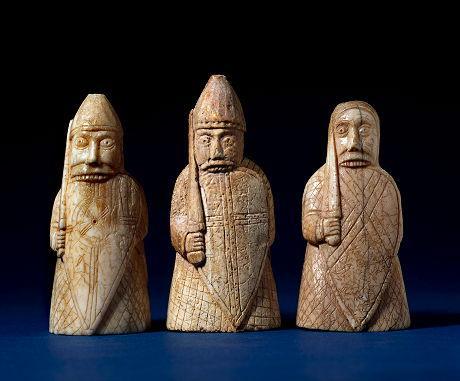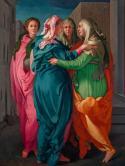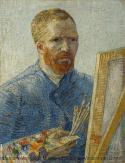Art Of The Day Weekly
#336 - from 6 March 2014 to 12 March 2014

The Lewis Chessmen, berserkers. Late 12th century, Uig, Lewis, Scotland. Walrus ivory. © The Trustees of the British Museum.
IN THE AIR
The Vikings, the return
They are mostly seen as thieves, brutal invaders who came to burn down Notre-Dame de Paris, and which were calmed down only when given Normandy. We can eventually grant them a few ill-written sagas but surely not the benefits of a true material civilisation. The British Museum has reopened the file on the Vikings. The conclusion does not change fundamentally, since the Vikings are described as warriors and remarkable sailors. In this exhibition we will admire the remains of the largest Viking ship, discovered in 1997 in Roskilde, Denmark. We also know they abused and looted other people and imposed their force. The cult they had for weapons, like their decorated swords prove it. But what we do not know as well is that they were also pioneers of a global civilisation. The treasures that have recently been shown, such as the Vale of York Hoard in England in 2007, show the extraordinary geographic diversity of their exchanges: certain jewels and coins come from Russia, Afghanistan and even Uzbekistan. We can easily say that after the Greeks and the Romans they were the designers of the ‘global civilisation’ we live in today.
• Vikings, life and legend at the British Museum, from 6 March to 22 June 2014.
EXHIBITIONS

Pontormo, Visitation, circa 1528-1529, oil on a panel, 202x156 cm. Carmignano, Pieve di San Michele Arcangelo
Pontormo vs. Rosso
FLORENCE – What exactly is the maniera? A virtuoso game of lengthening shapes, of strange perspectives, of esoteric motifs, and ‘electric’ colors. Mannerism was born in Italy just when the Renaissance was reaching for its breath and it developed throughout Europe. There were some brilliant centers, for example in Prague under king Rodolphe II. It was generally considered ‘decadent’, and was not always well-spoken of. This exhibition is remarkable in that it brings together two of its most important Italian figures. Pontormo (1494-1557) built all his career in Florence, going from Leonardo da Vinci’s workshop to that of Andrea del Sarto. Rosso Fiorentino (1494-1540) is on the contrary the ‘internationalist’: he made his fortune in the court of French king François Ier in Fontainebleau. The two artists were exact contemporaries and are placed face to face with works brought from near and far, from the Städel Museum in Frankfurt, the Walters Art Museum in Baltimore and the National Gallery in Washington. Certain paintings have rarely been seen before as they belong to private collections, such as the Portrait of a gentleman with a book by Pontormo, or from less known museums such as the superb Death of Cleopatra by Rosso, on loan from the Kunstmuseum of Brauschweig. These treasures make the confrontation the more complete.
• Pontormo e Rosso Fiorentino, divergenti vie della maniera at Palazzo Strozzi from 8 March to 30 July 2014

Vincent van Gogh (1853-1890), Self-Portrait as a painter, Paris, December 1887-February 1888. Oil on canvas. H. 65,1 ; L. 50 cm. Amsterdam, Van Gogh Museum (Fondation Vincent van Gogh) © Amsterdam, Van Gogh Museum (Fondation Vincent van Gogh)
Antonin Artaud studies Van Gogh
PARIS – Was Van Gogh crazy or was it society? This contained but original exhibition was inspired by a surprising manuscript from 1947. Pierre Loeb, the gallery owner who exposed Balthus and Giacometti, had asked Antonin Artaud to visit the Van Gogh retrospective that had opened at the Orangerie. Artaud went on 2 February 1947 to check whether the claims by the magazine Arts were true. They saw in the Dutch painter ‘an unbalanced individual with violent reactions of a maniac nature’. In the middle of the winter and for three weeks, Artaud wrote his Van Gogh, le suicidé de la société, which was rewarded the following year the Sainte-Beuve prize. He developed an interesting thesis, which is that Van Gogh, like all those people qualified as being ‘crazy’ was actually surprisingly lucid and it is society, stuck as it is in its conventions and scared of any truth that shakes it that chose to ostracise the artist and to push him to commit suicide. The thesis is supported in the exhibition by a selection of works by Van Gogh and his correspondence, face to face with Artaud’s drawings.
• Read: Catherine Bouthors-Paillart, Antonin Artaud, l’énonciation ou l’épreuve de la cruauté, Droz, 1997
• Van Gogh/Artaud. Le suicidé de la société at the musée d’Orsay, from 11 March to 6 July 2014.
Visiting Juba II
MARSEILLE – Volubilis is one of the most beautiful antique cities of Northern Africa. At the time of its great splendor, under king Juba II, at the beginning of the Ist century, it was the capital of the Roman province and Tingitane and the crib of a wealthy and cultivated society. These bronze figures of men and animals, considered as national treasures in Morocco, are sufficient proof of this past.
• Volubilis. Bronzes antiques du Maroc at the MuCEM, from 11 March to 25 August 2014.
Two hundred years ago, a certain Josephine
PARIS – She was repudiated by Napoleon but not by the French people. Two centuries after her death (in May 1814 at the castle of Malmaison) Josephine remains an important figure in French history. With a series of different objects -clothes, paintings, furniture, marriage documents-, the exhibition brings her back to life in her every day occupations of the socialite, Empress, lover of the arts, of travels and of flowers that she was.
• Joséphine at the Musée du Luxembourg, from 12 March to 29 June 2014.
Carl Larsson and a cosy side of Sweden
PARIS – Though his reproductions decorate all Swedish households, Carl Larsson (1853-1919) remained greatly unknown outside of Scandinavia. Some 120 works – references to every day life and rustic interiors of the Great North – will give us the opportunity to get to know this artist with very graphic lines.
• Carl Larsson, l’imagier de la Suède at the Petit Palais, from 7 March to 7 June 2014.
AUCTIONS

François-Louis Schmied (1873-1941), Le Vanneur, 1936, tempera on isorel, 111x140,5 cm. Estimate: €60,000-80,000.
Marcilhac's version of Art Deco
PARIS – Together with the Vallois he is one of the popes of the rediscovery of Art déco. As Félix Marcilhac moved to rue Bonaparte, he got rid of his personal collection. Among the 316 lots which impressed the international social circles there are some by great artists: a British-style wardrobe by Jean Dunand and Jean Goulden (estimate €300 000), a spectacular Nautilus armchair by Paul Iribe (€150 000), a cabinet by Jean-Michel Frank, with panels of gypsum patina (lot 63, €400 000). All the sectors of decorative arts are represented, from carpets to glass matt batttery (with, in particular, Marcel Marinot) and the auction should confirm or help unveil new values (Gustave Miklos, Joseph Csaky, François-Louis Schmied, Ernest Boiceau, Dutch painter Leonard Sarluis). In this universe of inaccessible prices, a few pieces remain reasonable: frames by Rose Adler or Jacques Adnet, drawings by Etienne Beothy, a stool by André Arbus, each for less than €10 000. At the beginning of the 1970s, prior to the boom of Art déco, one could have bought most of these masterpieces at this price!
• Félix Marcilhac, private collection, 12 March 2014 at Sotheby's (in association with Artcurial)
BOOKS
Emile Terry, literally
In this era where we are all chronically dependent on images, here is a strange book: though it presents the work of decorator Emilio Terry (1890-1969), one of the stars of the post war period, without a single illustration, except for the chapter headings, watercolors commissioned from Laurent de Commines. This is due to a conflict with the heirs who refused any reproduction, though Terry’s drawings were left to the School of Arts décoratifs. One has to have a great capacity of abstraction (and an internet connection to see for example the model of the spiral house) to penetrate this universe. The book is nevertheless very interesting, as Terry represents a generation of architects-decorators with great culture and an incomparable cosmopolitism. His family, natives from the county of Cork, in Ireland, made their fortune in Cuba in the sugar industry. Terry’s father owned the castle of Chenonceau for twenty years. All his children married European nobles -the de Castellane, Lucigny-Faucinge, etc. The chapters explore Emilio Terry’s major works, all late in life as he was already past fifty: the votive monument for Anna de Noailles, Niarchos’ town house in Paris, the castle of Groussay for Charles de Beistegui, villa Loste in the Basque region. Actually, this recollection can do very well without the images: it is the story of a long gone grandeur, inspired by the French XVIIIth century, a form of nostalgia.
• Emilio Terry, architecte et décorateur, by Pierre Arizzoli-Clémentel, Gourcuff-Gradenigo, 304 p., €69.


